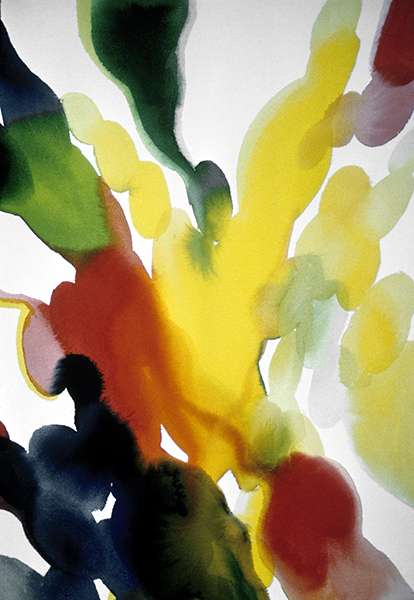World Watercolor Month: Alice Baber
Watercolor has come a long way since the days when it was only considered suitable for studies for oil paintings. It’s come an especially long way since the old timey days when “proper young ladies” learned watercolor as a “genteel” pursuit to undertake while forced to stay home all day. Actually, many of the most thrilling watercolor artists of the 1800s through to this century are women artists. I can’t think of anyone whose watercolors make my heart race like Alice Baber, a totally underappreciated artist (in standard art history texts, naturally). Those in the know appreciate her as yet another woman artist who came into her own during the domination of Abstract Expressionism in America and was not given her due until the 1970s and 1980s.
 |
| Alice Baber (1928–1982, U.S.), River Ladder Gold, 1972. Watercolor on paper, 30" x 22" (76 x 56 cm). Photo courtesy of the late artist. © 2020 Estate of Alice Baber. (8S-16797) |
River Ladder Gold presents the artist’s typical (radial) balance of forms and light space with a gentle flow and push-pull of colors. She built up her composition carefully in layers of thinned oil paint applied with linen rags. The thinned color was sometimes absorbed into the acrylic gesso base, or she would daub colors with a dry or turpentine-soaked rag to create transparency. Baber’s compositions often rely on the drama of contrasts of positive and negative shapes.
Many of Baber's compositions were memories of color and light from nature or mundane movement. River Ladder Gold references light reflections Baber saw in a moving river. Baber's basis in the circle varies greatly from painting to painting, from perfect circle to ovoid shape. Present in all her work, however, is the joy in color relationships and the way they coalesce, separate, and interact.
One of the most important abstract art movements in Europe after World War II (1939–1945) was an aesthetic similar to Abstract Expressionism. The movement was called Art Informel, and was characterized by bold color, energetic compositions, and loose, gestural brush work. Although Art Informel and Abstract Expressionism developed independently of each other, there was a consensus on both sides of the Atlantic that abstraction needed to shed the despotic geometric abstract styles of before the war in favor of an aesthetic that was spontaneous, emotional, and intuitive.
Lyrical Abstraction (Abstraction Lyrique) was a strain of Art Informel that featured serene, elegant forms—animated and harmonious—that were predominantly infused with content inspired by nature. An American version of this movement emerged during the 1960s and 1970s, mostly as a reaction against Minimalism, Conceptualism, and Hard Edge Art. The aim was a more painterly, sensuous style of rich color and forms inspired by aspects of nature. An exhibition called Lyrical Abstraction at the Whitney Museum in New York officially consecrated the style in 1971.
Baber's form of Lyrical Abstraction was concentrated on explorations of the circle as the perfect vehicle to express the possibilities of color and light. From an early age, Baber, born and raised on a farm in eastern Illinois, aspired to be an artist. At the age of 8 she studied perspective and drawing, and by 12 she was able to take college-level painting classes. She attended Lindenwood College for Women (now Lindenwood University) in St. Charles, Missouri, and then Indiana University at Bloomington. In the early 1950s, she moved to New York, then the vibrant new capital of modernism and epicenter of Abstract Expressionism, the so-called New York School. Starting in the 1950s, she also began spending half the year in Paris.
Baber considered 1958 to be the start of her mature style. Up until that point, she had painted objectively in a gestural style, always interested in harmonious combinations of brilliant color. Starting a painting of a still life of oranges called Battle of the Oranges, she sought a method for light to move across the whole composition. The vibrant warm colors she used made the blank space between them vibrate, and thus she came to the circle as the beginning of her personal image style.
Correlations to Davis programs: The Visual Experience 4E: 5.2; Experience Painting: Chapter 4


Comments